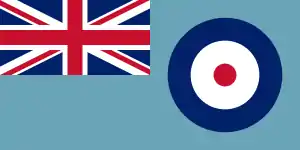RAF Honington
Royal Air Force Honington or more simply RAF Honington (IATA: BEQ, ICAO: EGXH) is a Royal Air Force station located 6 mi (9.7 km) south of Thetford near Ixworth in Suffolk, England. Although used as a bomber station during the Second World War, RAF Honington is now the RAF Regiment depot.
| RAF Honington | |||||||
|---|---|---|---|---|---|---|---|
| Near Thetford, Norfolk in England | |||||||
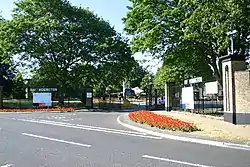 The main entrance to RAF Honington. | |||||||
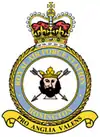 | |||||||
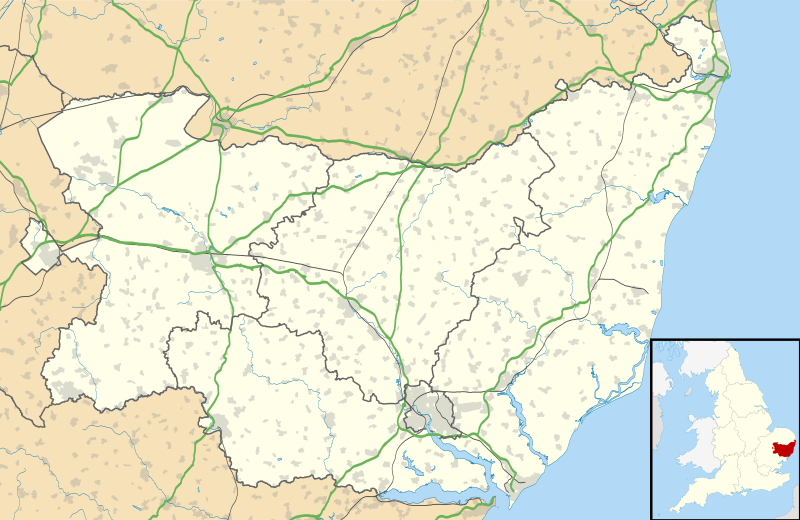 RAF Honington Shown within Suffolk | |||||||
| Coordinates | 52°20′33″N 000°46′23″E | ||||||
| Type | Air combat support station | ||||||
| Area | 779 hectares (1,920 acres)[2] | ||||||
| Site information | |||||||
| Owner | Ministry of Defence | ||||||
| Operator | Royal Air Force | ||||||
| Controlled by | No. 2 Group (Air Combat Support) | ||||||
| Condition | Operational | ||||||
| Website | https://www.raf.mod.uk/rafhonington/ | ||||||
| Site history | |||||||
| Built | 1935–1936 | ||||||
| In use |
| ||||||
| Garrison information | |||||||
| Current commander | Group Captain Matt M Radnall | ||||||
| Occupants |
| ||||||
| Airfield information | |||||||
| Identifiers | IATA: BEQ, ICAO: EGXH, WMO: 03586 | ||||||
| Elevation | 53 metres (174 ft) AMSL | ||||||
| |||||||
History
Royal Air Force use
Construction of Honington airfield, which was undertaken by John Laing & Son, began in 1935, and the facility was opened on 3 May 1937.[3] Squadrons of RAF Bomber Command using the airfield prior to the Second World War were:
- No. 77 Squadron RAF (Hawker Harts and Vickers Wellesleys) (July 1937 – July 1938)
- No. 102 Squadron RAF (Handley Page Heyford) (July 1937 – July 1938) – Moved to RAF Driffield
- No. 75 Squadron RAF (Handley Page Harrow and Vickers Wellington) (July 1938 – July 1939) – Moved to RAF Stradishall.
- No. 215 Squadron RAF (Harrow and Wellington) (July 1938 – July 1938) – Moved to RAF Bassingbourn.
- IX Squadron (Wellington Mk Is, later changing to Mk lAs.) (4 September 1939 – 1940).
IX Squadron flew the first RAF bombing raid of the Second World War on 4 September 1939 flying a mission against the Kriegsmarine in the Baltic resulting in the loss of two Wellingtons. The squadron lost 79 Wellingtons flying from Honington before moving to RAF Waddington.
In July 1940, No. 311 (Czech) Squadron RAF formed at Honington with Wellingtons, later moving to RAF East Wretham in November 1940.
The Luftwaffe made several attacks on the airfield one of which killed about twenty airmen who were crossing the old parade ground on their way to tea. Another bomb demolished part of Barrack Block 76, which was rebuilt between 1993 and 1996.
In 1941, a Junkers Ju 88 was shot down by ground fire from Honington. The aircraft crashed at the east end of E Hangar.
Then, in May of that year, a Wellington returning from a night trip attempted to land at Honington with its wheels retracted. It skidded to one side and crashed into the main bomb dump where it burst into flames. Group Captain J. A. Gray and Squadron Leader J. A. McCarthy, the station medical officer, were the first on the scene of the crash. Both entered the burning aircraft in an attempt to rescue the crew who were trapped and, between them, two crew-members were saved. For this gallantry, both officers were awarded the George Medal.[4]
United States Army Air Forces use
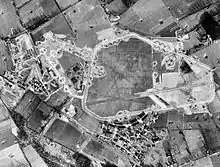
In June 1942, the airfield was transferred to the USAAF and was upgraded to a Class A Bomber base. Honington was assigned USAAF designation Station 375.
USAAF Station Units assigned to RAF Honington were:[5]
- 314th Service Group[6]
- 467th Service Squadron; HHS 314th Service Group
- 18th Weather Squadron
- 68th Station Complement Squadron
- 9th Depot Repair Squadron
- Headquarters (Western Base Section)
Regular Army Station Units included:
- Headquarters & Headquarters Battery (386th Anti-Aircraft Artillery Battalion)
- 386th Anti-Aircraft Artillery AW Battalion
- 386th Anti-Aircraft Artillery Battalion
- 1097th Signal Company
- 1178th Quartermaster Company
- 1221st Military Police Company
- 1599th Ordnance Supply & Maintenance Company
- 2017th Engineer Fire Fighting Platoon
1st Strategic Air Depot
Under USAAF control, an additional facility, called Troston, was constructed to the west of the main airfield as a specialized air depot for the repair of badly-damaged B-17 Flying Fortress bombers and supporting the 3d Bomb Division located in the area. Badly damaged Fortresses were often instructed to crash land at Honington on return from operations, particularly if their landing gear could not be lowered, as this avoided the necessity to dismantle and transport the aircraft from its home base for repair.[5]
364th Fighter Group
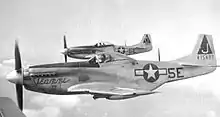
In addition to the air depot, Honington also housed an operational fighter unit when the 364th Fighter Group took up residence at Honington in February 1944, arriving from Santa Maria AAF, California. The group was under the command of the 67th Fighter Wing of the VIII Fighter Command. Aircraft of the 364th were identified by a blue/white stripe pattern around their cowlings.
The group consisted of the following squadrons:
- 383d Fighter Squadron (N2)
- 384th Fighter Squadron (5Y)
- 385th Fighter Squadron (5E)
The 364th FG flew escort, dive-bombing, strafing, and patrol missions in France, Belgium, the Netherlands, and Germany. At first, the group operated primarily as escort for B-17/Consolidated B-24 Liberator heavy bombers.
The group patrolled the English Channel during the Normandy invasion in June 1944, and, while continuing escort operations, supported ground forces in France after the invasion by strafing and bombing locomotives, marshalling yards, bridges, barges, and other targets.
Converted from Lockheed P-38 Lightnings to North American P-51 Mustangs in the summer of 1944 and from then until the end of the war flew many long-range escort missions heavy bombers that attacked oil refineries, industries, and other strategic objectives at Berlin, Regensburg, Merseburg, Stuttgart, Brussels, and elsewhere. The 364th received a Distinguished Unit Citation for an escort mission on 27 December 1944 when the group dispersed a large force of German fighters that attacked the bomber formation the group was escorting on a raid to Frankfurt.
The 364th also flew air-sea rescue missions, engaged in patrol activities, and continued to support ground forces as the battle line moved through France and into Germany. Took part in the effort to invade the Netherlands by air, September 1944; the Battle of the Bulge, December 1944 – January 1945; and the assault across the Rhine, March 1945.
Although the last mission by the 364th took place on 25 April 1945, the group did not depart until November, returning to Camp Kilmer, New Jersey, for inactivation. Even then, Honington remained the lone Eighth Air Force outpost in the UK becoming Fighter Command HQ on 5 October.
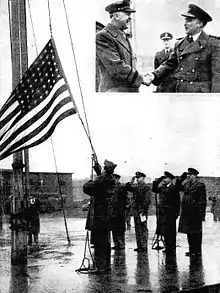
Honington was the last USAAF station to be returned to the RAF. By the beginning of 1946, the airfield remained the only active station which had been used by the Eighth Air Force and a fitting ceremony was planned to mark its closure and official handing back to the Royal Air Force. On 26 February, Brigadier General Emil Kiel – the Eighth Fighter Command commander – was present to hand over the keys of the station to Air Marshal Sir James Robb, AOC RAF Fighter Command. An RAF band played The Star-Spangled Banner as the Stars and Stripes were lowered for the RAF Ensign to be hoisted in its place. The airfield, which was the first transferred to the United States Army Air Forces for its use in 1942, was the last to be returned to the Air Ministry.
Back to Royal Air Force control
With the departure of the USAAF in February 1946, Honington airfield was returned to the RAF.
It became a major servicing centre for RAF Transport Command aircraft. During the Berlin Airlift, RAF Honington played a major role in keeping the aircraft of Transport Command flying. In 1949, the station reverted to Bomber Command.
From 1950 to 1956, RAF Honington housed No. 94 Armament Maintenance Unit for bomb storage. The airfield was upgraded during this time to include a 9,000 ft concrete runway.
English Electric Canberra bomber squadrons, 10, XV, 44, and 57 were based at RAF Honington from February 1955 to 1957. 10 and XV Squadrons took part in the Suez Crisis of 1956.
In 1956, RAF Honington also became one of the main V bomber bases maintaining three Vickers Valiant squadrons, Nos, 7, 90, and 199. Later Handley Page Victor Squadrons, 55 and 57 were added. New facilities were constructed including a large East-West runway. These squadrons left in 1965 and the airfield was placed in reserve for conversion to accommodate the new General Dynamics F-111 fleet. While in reserve, Honington Married Quarters were used to accommodate evacuees from the Aden Emergency in 1967, as recorded in the book "From Barren Rocks to Living Stones".
In the event, the F-111 never entered service with the RAF, and in 1968, the airfield became the UK base for the RAF's Hawker Siddeley (Blackburn) Buccaneer bomber. The first aircraft arrived in November 1969 and deliveries continued throughout the early 1970s. Nos. 12, 15 and 16 squadrons were formed. 15 and 16 squadrons moved to RAF Laarbruch in West Germany in 1971. These were followed by No. 237 OCU (Operational Conversion Unit) which was formed when the RAF took over Buccaneer training from the Royal Navy, then finally 208 and briefly 216 squadrons.

The station was then selected to become a base for the RAF's Panavia Tornado fleet with the Tornado Weapons Conversion Unit (TWCU) established there in 1981. The UK-based Buccaneer fleet (12, 208, and 237 OCU) were relocated to RAF Lossiemouth in Scotland.
In August 1982 IX(B) Squadron reformed at RAF Honington, becoming the world's first operational Tornado squadron, with the squadron's equipment including the WE.177 nuclear laydown bomb. IX Squadron relocated to RAF Bruggen in Germany in 1986, leaving the TWCU (which had acquired the "shadow" designation of No. 45 Squadron in 1983) was the sole occupant until XIII Squadron formed there in January 1990.
At this time only one RAF Regiment Sqn was based at Honington, 20 Sqn. Their equipment was sent to the Gulf via Hercules aircraft from RAF Lyneham.
RAF Regiment Depot
On 15 July 1992, it was announced that the Tornados would depart Honington and that the station would relinquish its primary flying role and become the RAF Regiment Depot.[7] As a result, the TWCU moved to Lossiemouth (to replace the Buccaneers) in November 1993. Honington ceased to be a flying station on 1 February 1994 when No. 13 Squadron relocated to RAF Marham.[8]
RAF Honington became the RAF Regiment Depot in June 1994, when RAF Catterick in North Yorkshire, home of the existing depot, closed.[9]
RAF Honington became the home to 611 Volunteer Gliding Squadron due to the closure of RAF Watton in April 2012, requiring their conversion to the Grob 109B Vigilant motor glider until the closure of that unit in 2016.
During 2018, No. 2 Squadron RAF Regiment moved to RAF Brize Norton in Oxfordshire, completing the move in September of that year.[10]
No. 20 Wing RAF Regiment (Defence Chemical, Biological, Radiological and Nuclear (CBRN) Wing) disbanded on 1 April 2019 having been at Honington since 2011. The CBRN role was taken over by 28 Engineer Regiment of the British Army, with No. 27 Squadron RAF Regiment coming under the army's command.[11]
Role and operations
RAF Honington's mission statement is "Delivering Air Force Protection Capability for the RAF and Defence".[12] The station is the single hub for RAF Force Protection, incorporating the RAF Regiment Headquarters and the RAF Police Headquarters. Together they are responsible for protecting the RAF at home and abroad. The station is home to over 1,500 military personnel, civil servants and contractors.[13]
Command
Group Captain Matt M Radnall MA RAF was appointed station commander of Honington in December 2018.[13] Prince Harry, Duke of Sussex, was Honorary Air Commandant from 2008 to spring 2020. [14]
The station is under the command of No. 2 Group (Air Combat Support).[15]
RAF Regiment
RAF Honington is home to three front-line RAF Regiment field squadrons. Through the RAF Force Protection Centre and RAF Regiment Training Wing, the station also provides initial and advanced training for members of the RAF Regiment and specialist training for the RAF's entire Force Protection capability.[13]
RAF Police
The RAF Police is the service police branch of the Royal Air Force and Honington is home to the RAF Police Headquarters. It also accommodates No. 1 (Tactical) Police Squadron which provides field policing, and reserve unit No. 3 (Tactical) Police Squadron (Royal Auxiliary Air Force) which provides a general policing and aviation security capability.[13]
Based units
The following notable units are based at RAF Honington.[16][17][18][19]
Royal Air Force
No. 2 Group (Air Combat Support) RAF
- RAF Force Protection
- RAF Force Protection Headquarters
- RAF Force Protection Centre
- RAF Regiment Training Wing
- No. 2 RAF Force Protection Wing
- No. 1 (Tactical) Police Squadron
- No. 7 RAF Force Protection Wing
- No. 8 RAF Force Protection Wing
- RAF Police Headquarters
- No. 3 (Tactical) Police Squadron (Royal Auxiliary Air Force)
- Specialist and Security Police Wing
- Regional Rehabilitation Unit
British Army
Royal Engineers (8 Engineer Brigade, 12 (Force Support) Engineer Group)
Civilian
- RAF Regiment Heritage Centre
- RAF Honington Flying Club – Piper PA-28
Heritage
Station badge and motto
RAF Honington's badge, awarded in June 1956, features the head of St. Edmund in front of two crossed arrows pointing downwards. The head of St. Edmund represents the nearby town of Bury St Edmunds which is approximately 9 km (5.59 mi) to the south east of the station, in whose coat of arms the representation is featured. The arrows in saltire, represent St. Edmund's martyrdom.[20]
The station's motto (Pro anglia valens) is in Latin and translates into English as Valiant for England.[20]
Built heritage

Two Second World War era hardened field fortification survive within the airfield boundary. The Pickett-Hamilton forts were designated as scheduled monuments by English Heritage (now Historic England) in September 2002. The forts were constructed in late 1940 in order to provide ground defence for the airfield. A third example is thought to have been destroyed during redevelopment of the station after the war.[21]
The forts were designed to be lowered into the ground while not in use, as such they would be inconspicuous and would not interfere with the passage of taxiing aircraft or other vehicles. The forts could be raised to about 2 feet 6 inches (0.76 m) above ground level where it would be a physical impediment to aircraft and vehicles and from where a small crew could fire with rifles or light machine guns.[22]
The examples at Honington are described by Historic England as having "importance as comparatively rare surviving examples of an unusual and innovative type of airfield defence installation. The outer structure and lifting heads of both remain in good condition, and the example which is in working order, with its principal internal fittings intact, is of particular interest."[21]
Former units
The following units were here at some point:[23]
- No. 1 Transport Aircraft Modification Unit RAF
- No. 3 Group Practice Flight RAF (1937)
- No. 5 Blind Approach Training Flight RAF
- No. 13 Blind Approach Training Flight RAF
- No. 58 Maintenance Unit RAF
- No. 103 Gliding School RAF
- No. 237 Operational Conversion Unit RAF
- No. 611 Volunteer Gliding Squadron RAF
- No. 1504 (Beam Approach Training) Flight RAF
- No. 1505 (Beam Approach Training) Flight RAF
- No. 1513 (Beam Approach Training) Flight RAF
- Avionic Development and Servicing Unit (Buccaneer) RAF
- Joint Rapier Training Unit RAF
- Rapier Training Unit RAF
- Strike Command Avionics Development and Servicing Unit RAF
- Strike Command Buccaneer Force RAF
- Tornado Weapons Conversion Unit RAF
- Transport Command Major Servicing Unit RAF
- Transport Command Signals Training Unit RAF
See also
References
![]() This article incorporates public domain material from the Air Force Historical Research Agency website http://www.afhra.af.mil/.
This article incorporates public domain material from the Air Force Historical Research Agency website http://www.afhra.af.mil/.
Citations
- Pine, L.G. (1983). A dictionary of mottoes (1 ed.). London: Routledge & Kegan Paul. p. 181. ISBN 0-7100-9339-X.
- "Defence Estates Development Plan 2009 – Annex A". GOV.UK. Ministry of Defence. 3 July 2009. p. 15. Retrieved 26 March 2019.
- Ritchie, p. 91
- London Gazette Issue 35270 published on 9 September 1941. Page 1
- "Honington". American Air Museum in Britain. Retrieved 16 March 2015.
- "314th Service Group". American Air Museum in Britain. Retrieved 16 March 2015.
- March, Peter R. (1998). Brace by Wire to Fly-By-Wire – 80 Years of the Royal Air Force 1918–1998. RAF Fairford: Royal Air Force Benevolent Fund Enterprises. p. 158. ISBN 1-899808-06-X.
- March, Peter R. (1998). Brace by Wire to Fly-By-Wire – 80 Years of the Royal Air Force 1918–1998. RAF Fairford: Royal Air Force Benevolent Fund Enterprises. p. 162. ISBN 1-899808-06-X.
- March, Peter R. (1998). Brace by Wire to Fly-By-Wire – 80 Years of the Royal Air Force 1918–1998. RAF Fairford: Royal Air Force Benevolent Fund Enterprises. p. 162. ISBN 1-899808-06-X.
- Cooper, Tim (25 September 2018). "RAF Regiment Squadron Receives New Standard". Forces Network. Retrieved 18 October 2018.
- "27 Squadron RAF Regt – 20 Wg The End of the Beginning". Honington Herald. Lance Print: 9. Summer 2019.
- "Jeffrey's 100 Mile Walk". Honington Herald. Forces and Corporate Publishing Ltd.: 22 Winter 2018.
- "RAF Honington". Royal Air Force. Retrieved 19 April 2019.
- "Wattisham and Honington personnel to flank Royal wedding route". Suffolk Free Press. Iliffe Media Publishing Ltd. 28 March 2018. Retrieved 19 April 2019.
- "No 2 Group". Royal Air Force. Retrieved 19 April 2019.
- "RAF Honington – Who's Based Here". Royal Air Force. Retrieved 15 November 2019.
- "Force Protection – RAF Police". Royal Air Force. Retrieved 16 July 2018.
- "RAF Honington Flying Club". RAF Flying Clubs' Association. Archived from the original on 2 February 2008. Retrieved 23 July 2017.
- "Force Troops Command Handbook". Retrieved 31 March 2019.
- "Honington". RAF Heraldry Trust. Retrieved 19 April 2019.
- Historic England. "Two Pickett-Hamilton forts at Honington airfield, 750m and 1.25 km south west of Broomhill Cottages (1020779)". National Heritage List for England. Retrieved 20 April 2019.
- Pickett & Hamilton 1940.
- "Honington". Airfields of Britain Conservation Trust. Retrieved 10 February 2016.
Bibliography
- Freeman, Roger A., Airfields of the Eighth, Then And Now, 1978
- Honington www.controltowers.co.uk
- Honington mighty8thaf.preller.us
- Maurer Maurer, Air Force Combat Units of World War II, Office of Air Force History, 1983
- Baugher, J USAAS-USAAC-USAAF-USAF Aircraft Serial Numbers—1908 to present
- Pickett, Francis Norman; Hamilton, Donald St Aubyn (12 July 1940). "An improved means for the protection of aerodromes, aircraft landing fields and other situations (patent)". Espacenet. Retrieved 23 September 2016.
- Ritchie, Berry (1997). The Good Builder: The John Laing Story. James & James.
External links
| Wikimedia Commons has media related to RAF Honington. |
- Official website
- Honington Herald – RAF Honington station magazine
- RAF Regiment Heritage Centre
